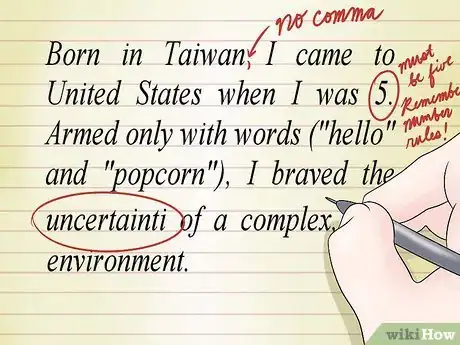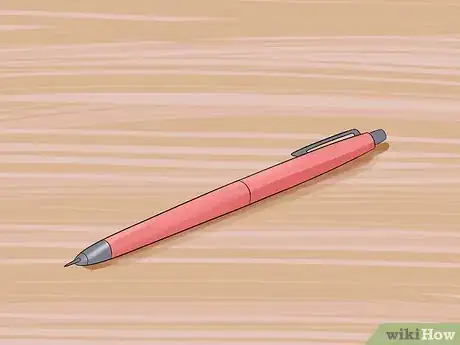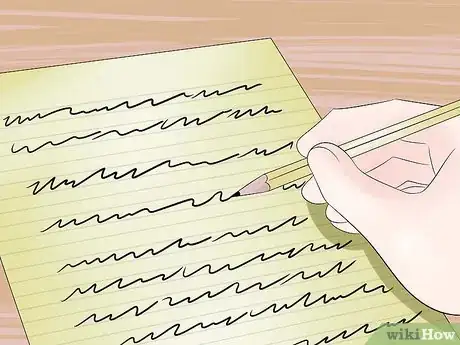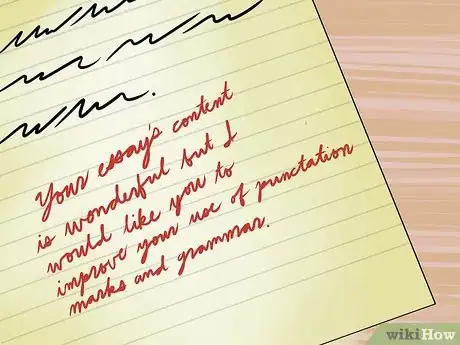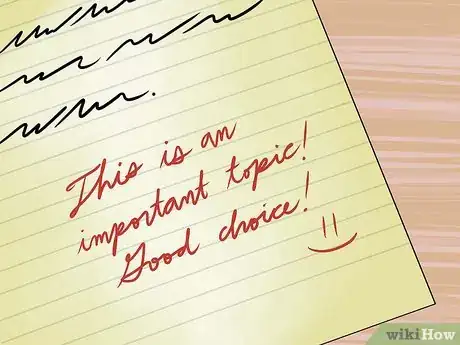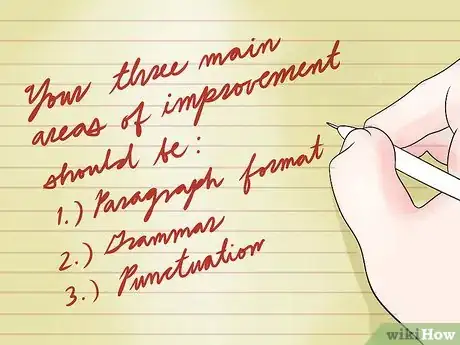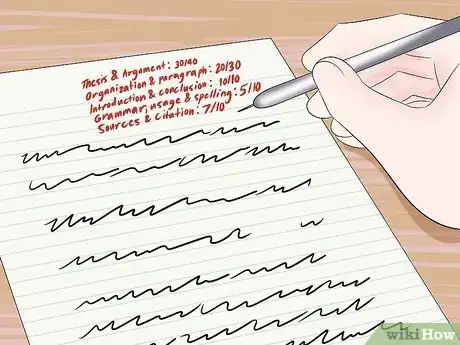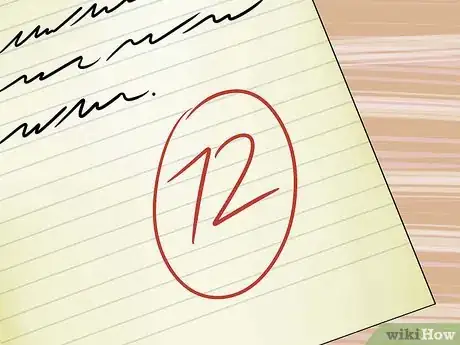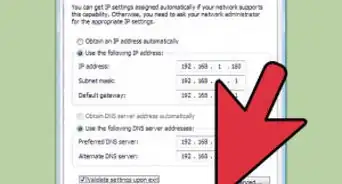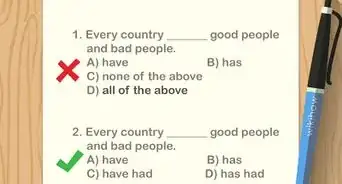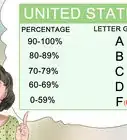wikiHow is a “wiki,” similar to Wikipedia, which means that many of our articles are co-written by multiple authors. To create this article, 15 people, some anonymous, worked to edit and improve it over time.
There are 8 references cited in this article, which can be found at the bottom of the page.
This article has been viewed 74,630 times.
Learn more...
Anyone can mark answers right and wrong, but a great teacher can mark up a paper in such a way as to encourage a student who needs it and let good students know they can do better. As the great poet and teacher Taylor Mali put it: "I can make a C+ feel like a Congressional Medal of Honor and I can make an A- feel like a slap in the face."
Steps
Going Through an Essay
-
1Learn the difference between major and minor errors. Sometimes called "higher" and "lower" concerns, it's important to prioritize major issues like content, creative thinking, and organization over more minor issues like grammar, usage, and spelling.[1]
- These designations obviously depend upon many things, like the assignment, the grade-level of your students, and their individual concerns. If you're in the middle of a unit on comma usage, it's perfectly fine to call that a "higher" concern. But in general, a basic writing assignment should prioritize the higher concerns listed above.
-
2Read the paper through once without marking anything. When you've got a stack of 50 or 100 papers to go through and another stack of quizzes to finish and lessons to plan it can be tempting to jump right in and start slapping Bs on everything.[2] Resist that temptation. Read through each essay individually before marking anything. Look for the highest order of concerns first:
- Does the student address the prompt and fulfill the assignment effectively?
- Does the student think creatively?
- Does the student clearly state their argument, or thesis?
- Is the thesis developed over the course of the assignment?
- Does the writer provide evidence?
- Does the paper show evidence of organization and revision, or does it seem like a first draft?
Advertisement -
3Keep the red pen in your desk. Getting an assignment back that looks like someone bled all over it can be a source of great anxiety in the life of a student. Some teachers argue that red asserts authority. While that may be true, there are other ways to assert your authority than pen color.[3]
- Marking essays in pencil can suggest that the issues are easily fixable, keeping the student looking forward, rather than dwelling on their success or failure. Pencil, blue, or black pen is perfectly appropriate.
-
4Read through the paper again with your pencil ready. Write comments, criticisms, and questions in the margins as neatly as possible. Find moments that the writer needs to clarify and circle them or underline them.[4]
- Be as specific as possible when asking questions. "What?" is not a particularly helpful question to scrawl in the margin, compared to "What do you mean by 'some societies'?"
-
5Proofread for usage and other lower-order concerns. When you've addressed the most important issues of the essay, its content, feel free to mark some lower-order concerns, like usage, grammar, and punctuation. Depending on the grade-level of the essays and the skill-level of your students, these may be more or less important. Typical proofreading marks include the following:[5]
- ¶ = to start a new paragraph
- three underscores under a letter = to lowercase or uppercase the letter
- "sp" = word is spelled incorrectly
- word crossed out with a small "pigtail" above = word needs to be deleted
- Some teachers use the first page as a rule of thumb for marking later concerns. If there are sentence-level issues, mark them on the first page and then stop marking them throughout the essay, especially if the assignment needs more revision.
Writing Effective Comments
-
1Write no more than one comment per paragraph and a note at the end. The goal of comments is to point out the strengths and weaknesses in a student's writing and to offer them concrete strategies toward improving their work. Completely shredding apart a failed paragraph with your red pen does not accomplish any of these aims.[6]
- Use marginal comments to point out specific points or areas in the essay the student could improve.
- Use a paragraph note at the end to summarize your comments and direct them toward improvement.
- Comments should not justify a letter grade. Never start a note, "You got a C because...". It's not your job to defend the grade given. Instead, use the comments to look toward revision and the next assignment, rather than staring backward at the successes or failures of the given assignment.
-
2Find something to praise. Try to start your comments by finding something the student has done well and encouraging them. Seeing exclamation points or "Good job" on an essay tends to be more memorable for the student, and will ensure that they'll repeat the behavior.[7]
- If you struggle to find anything, you can always praise their topic selection: "This is an important topic! Good choice!"
-
3Address three main issues of improvement in your note. Even if your student has written a disaster of a paper, don't overwhelm them with every single thing that needs to be fixed. Try to focus on no more than three main areas of improvement in your comments. This will give the student concrete strategies toward improvement, and avoid overwhelming them with "failures."[8]
- When you give your first read-through, Try to determine what these three points might be to make it easier when you're going through the paper and writing comments.
-
4Encourage revision. Instead of focusing your comments on everything the student did wrong in an essay, direct your comments toward the next essay, or toward a re-write of the current essay, if that fits in with the conventions of the assignment.[9]
- "In your next assignment, make sure to organize your paragraphs according to the argument you're making" is a better comment than "Your paragraphs are disorganized."
Assigning Letter Grades
-
1Use a rubric and let the students see it. A rubric is used to assign numerical values to various criteria used to make up the letter grade, usually based on a scale of 100. To get a letter grade, you assign numerical values to each section and tally the score. Making the students aware of the rubric used will keep the process transparent and eliminate the idea that you pull arbitrary grades out of nowhere. A rubric, for example, might look like this:[10]
- Thesis and argument: _/40
- Organization and paragraphs: _/30
- Introduction and conclusion: _/10
- Grammar, usage, and spelling: _/10
- Sources and Citations: _/10
-
2Know or assign a description of each letter grade. Let the students see a description of what an A means, what a B means, etc. Write your own according to your own specific criteria and emphasis for the class. Share it with the students so they can interpret the grade they receive. These are fairly standard designations, often worded like this:[11]
- A (100-90): Work completes all of the requirements of the assignment in an original and creative manner. Work at this level goes beyond the basic guidelines of the assignment, showing the student took extra initiative in originally and creatively forming content, organization, and style.
- B (89-80): Work completes all of the requirements of the assignment. Work at this level is successful in terms of content, but might need some improvement in organization and style, perhaps requiring a little revision. A B reveals less of the author’s original thought and creativity than A-level work.
- C (79-70): Work completes most of the requirements of the assignment. Though the content, organization, and style are logical and coherent, they may require some revision and may not reflect a high level of originality and creativity on the part of the author.
- D (69-60): Work either does not complete the requirements of the assignment, or meets them quite inadequately. Work at this level requires a good deal of revision, and is largely unsuccessful in content, organization, and style.
- F (Below 60): Work does not complete the requirements of the assignment. In general, students who put forth genuine effort will not receive an F. If you receive an F on any assignment (particularly if you feel you have given adequate effort), you should speak with me personally.
-
3Make the grade the last thing the student sees. Put the grade at the very end of the paper, after they've seen the rubric and your comments. Slapping a big letter grade at the top near the title will ensure that the student probably won't go through and read all the smart and helpful comments you've included.
- Some teachers like to hand out papers at the end of the day because they fear discouraging or distracting students during class time. Consider giving the students time to go through the papers in class and be available to talk about their grades afterwards. This will ensure that they read and understand your comments.
Community Q&A
-
QuestionHow do I grade a math test?
 Christopher SitCommunity AnswerThe best way is to base each question on a certain criteria. For example, if you had your students complete a word problem on multiplication, you would need to make sure they showed their work, did the math correctly, and followed instructions. You could give a certain number of points for each criteria. For example, a student could get partial credit for following instructions and showing work, even if they did not arrive at the correct answer.
Christopher SitCommunity AnswerThe best way is to base each question on a certain criteria. For example, if you had your students complete a word problem on multiplication, you would need to make sure they showed their work, did the math correctly, and followed instructions. You could give a certain number of points for each criteria. For example, a student could get partial credit for following instructions and showing work, even if they did not arrive at the correct answer. -
QuestionWhat would my grade be if I have 11 questions on my paper and I only get 8 right?
 HelpingHand45Community AnswerThe answer would be 8 out of 11, which translates to roughly a 73%. This is a C grade at most public teaching centers.
HelpingHand45Community AnswerThe answer would be 8 out of 11, which translates to roughly a 73%. This is a C grade at most public teaching centers. -
QuestionIf I miss one question out of fifteen, what's my grade?
 Community AnswerThe score is 93.3%, which is an A on most US grading scales.
Community AnswerThe score is 93.3%, which is an A on most US grading scales.
Warnings
- Always use a rubric to keep yourself safe from grade appeals. You don't want to have to defend subjective grades.⧼thumbs_response⧽
Things You'll Need
- Something to write with
- A stack of papers
- A stiff beverage
References
- ↑ https://public.wsu.edu/~campbelld/grading.html
- ↑ http://depts.washington.edu/pswrite/grading.html
- ↑ https://phys.org/news/2013-01-red-pen-instructors-negative-response.html
- ↑ https://gsi.berkeley.edu/gsi-guide-contents/student-writing-intro/grading/
- ↑ https://sites.google.com/a/georgetown.edu/prof-william-blattner/resources-for-students/abbreviations-on-returned-papers
- ↑ https://gsi.berkeley.edu/gsi-guide-contents/student-writing-intro/grading/
- ↑ https://writing-speech.dartmouth.edu/teaching/first-year-writing-pedagogies-methods-design/diagnosing-and-responding-student-writing
- ↑ https://gsi.berkeley.edu/gsi-guide-contents/student-writing-intro/grading/
- ↑ https://writing-speech.dartmouth.edu/teaching/first-year-writing-pedagogies-methods-design/diagnosing-and-responding-student-writing
About This Article
To grade a paper, start by reading it without marking it up to see if it has a clear thesis supported by solid evidence. Then, go back through and write comments, criticism, and questions in the margins. Make sure to give specific feedback, such as “What do you mean by ‘some societies’?” instead of something like “What?” Try to limit yourself to 1 comment per paragraph so you don’t overwhelm the student. You can also write a note at the end, but start with praise before focusing on issues the student should address. For information on how to assign grades to your students’ papers, keep reading!
